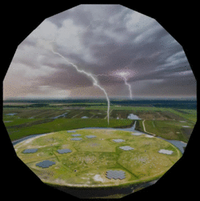How is lightning initiated in thunderclouds? This is difficult to answer – how do you measure electric fields inside large, dangerously charged clouds? It was discovered, more or less by coincidence, that cosmic rays provide suitable probes to measure electric fields within thunderclouds. This surprising finding will be published in Physical Review Letters on April 24nd. The measurements were performed with the LOFAR radio telescope located in the Netherlands, and is interpreted by researchers from the University of Groningen (RUG), the Radboud University, the Free University Brussels (VUB) and Centrum Wiskunde & Informatica (CWI) in Amsterdam.
'We used to throw away LOFAR measurements taken during thunderstorms. They were too messy.' says astronomer Pim Schellart. 'Well, we didn't actually throw them away of course, we just didn't analyze them.' Schellart, who completed his PhD in March this year at Radboud University in Nijmegen and is supervised by Prof. Heino Falcke, is interested in cosmic rays. These high-energy particles, originating from exploding stars and other astrophysical sources, continuously bombard Earth from space. High in the atmosphere these particles strike atmospheric molecules and create 'showers' of elementary particles. These showers can also be measured from the radio emission that is generated when their constituent particles are deflected by the magnetic field of the Earth. The radio emission also gives information about the original particles. These measurements are routinely conducted with LOFAR at ASTRON in Dwingeloo, but not during thunderstorms...
Modelling work
To analyze this data, astrophysicist Prof. Olaf Scholten (RUG) and ‘lightning professor’ Ute Ebert from CWI started a joint project, ‘Cosmic lightning’. This group, with PhD student Gia Trinh (RUG) and others, modeled how the electric field in thunderstorms can explain the different measurements. 'This worked very well. How the radio emission changes gives us a lot of information about the electric fields in thunderstorms. We could even determine the strength of the electric field at a certain height in the cloud.' says Schellart.
This field can be as strong as 50 kV/m. This translates into a voltage of hundreds of millions of volts over a distance of multiple kilometers: a thundercloud contains enormous amounts of energy.
Dangerous charge
Lightning is a highly unpredictable natural phenomenon that inflicts damage to infrastructure and claims victims around the world. This new method to measure electric fields in thunderclouds will contribute to a better understanding and ultimately better predictions of lightning activity. Current measurement methods from planes, balloons or little rockets are dangerous and too localized. Most importantly the presence of the measurement equipment influences the measurements. Cosmic rays probe the thunderclouds from top to bottom. Moving at almost the speed of light they provide a near instantaneous 'picture' of the electric fields in the cloud. Moreover, they are created by nature and are freely available.
“I am very happy with the interdisciplinary collaboration between astronomers, particle physicists and us”, Ute Ebert says. “The results will play a crucial role in our understanding of the creation and evolution of lightning.”
The modelling work was funded through the FOM project “Cosmic Lightning” .
Caption illustration: A particle shower initiated by a cosmic ray reaches LOFAR through a thundercloud. Image credit Radboud University.
Animation:

Animation: an 1.5 TeV proton evolving from 20 km altitude. After the simulation the paths of the particles are displayed for 10 seconds after which the cycle will repeat itself.
In color coding:
- purple: gamma rays
- yellow: electrons and positrons
- blue: protons
- cyan: neutrons
- green: pions
The particle size is scaled to their energy. Credit: CWI
More information
- Probing atmospheric electric fields in thunderstorms through radio emission from cosmic-ray induced air showers.P. Schellart e.a, Physical Review Letters 22 april 2015
- Multiscale Dynamics research group (CWI)
- Press release Radboud Universiteit
Illustratie: Een deeltjesdouche veroorzaakt door een kosmische inslag bereikt LOFAR door een donderwolk. Bron: Radboud University.
This research was made possible by funding from the ERC, FOM (project Cosmic Lighting), NWO en NOVA, and was a collaborative effort by researchers from Radboud Univerisity, Centrum Wiskunde & Informatica (CWI), ASTRON, KVI Rijksuniversiteit Groningen, Vrije Universiteit Brussel and many others. For a full author list see the paper.
